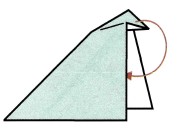Florence Temko - Origami Holiday Decorations: Make Festive Origami Holiday Decorations with This Easy Origami Book: Includes Origami Book with 25 Fun & Easy Projects
Here you can read online Florence Temko - Origami Holiday Decorations: Make Festive Origami Holiday Decorations with This Easy Origami Book: Includes Origami Book with 25 Fun & Easy Projects full text of the book (entire story) in english for free. Download pdf and epub, get meaning, cover and reviews about this ebook. year: 2012, publisher: Tuttle Publishing, genre: Home and family. Description of the work, (preface) as well as reviews are available. Best literature library LitArk.com created for fans of good reading and offers a wide selection of genres:
Romance novel
Science fiction
Adventure
Detective
Science
History
Home and family
Prose
Art
Politics
Computer
Non-fiction
Religion
Business
Children
Humor
Choose a favorite category and find really read worthwhile books. Enjoy immersion in the world of imagination, feel the emotions of the characters or learn something new for yourself, make an fascinating discovery.
- Book:Origami Holiday Decorations: Make Festive Origami Holiday Decorations with This Easy Origami Book: Includes Origami Book with 25 Fun & Easy Projects
- Author:
- Publisher:Tuttle Publishing
- Genre:
- Year:2012
- Rating:4 / 5
- Favourites:Add to favourites
- Your mark:
Origami Holiday Decorations: Make Festive Origami Holiday Decorations with This Easy Origami Book: Includes Origami Book with 25 Fun & Easy Projects: summary, description and annotation
We offer to read an annotation, description, summary or preface (depends on what the author of the book "Origami Holiday Decorations: Make Festive Origami Holiday Decorations with This Easy Origami Book: Includes Origami Book with 25 Fun & Easy Projects" wrote himself). If you haven't found the necessary information about the book — write in the comments, we will try to find it.
Beautify your home or classroom for the holidays with unique and elegant origami paper craft ornaments by world renowned origami artist, Florence Temko. Origami Holiday Decorations, is the festive origami design book with 25 fun-to-do 3D paper model projects that includes step-by-step instructions and color diagrams
Origami is the ideal craft for anyone who likes to create with their hands. The paper craft projects in this book can help you express your creativity by folding wonderful decorations out of single sheets of paper. Origami Holiday Decorations features designs for origami decorations that range from traditional to unique, simple to complex. Each model is explained with easy-to-follow diagrams and illustrated with a photograph of the finished project. A section on paper folding techniques makes it easy to get started, with special tips on how to adapt your origami projects to different sizes and papers. This easy origami book is sure to provide hours of entertainment for both children and adults.
This origami book contains:
Origami projects include:
Florence Temko: author's other books
Who wrote Origami Holiday Decorations: Make Festive Origami Holiday Decorations with This Easy Origami Book: Includes Origami Book with 25 Fun & Easy Projects? Find out the surname, the name of the author of the book and a list of all author's works by series.















 ABOUT CHRISTMAS, HANUKKAH, AND KWANZAA CHRISTMAS Christmas was first celebrated in Europe in the fourth century on the 25th day of December to commemorate the birth of the Christ child. Since then, many symbols have become associated with the festivity. Decorating evergreen trees with ornaments became an enduring tradition, representing long life and immortality. In the sixteenth century German people commonly decorated fir trees with flowers, fruit, and even pieces of paper. Candles were added later on to emulate the twinkling of stars. The name of Santa Claus, the gift giver, is the abbreviation of St.
ABOUT CHRISTMAS, HANUKKAH, AND KWANZAA CHRISTMAS Christmas was first celebrated in Europe in the fourth century on the 25th day of December to commemorate the birth of the Christ child. Since then, many symbols have become associated with the festivity. Decorating evergreen trees with ornaments became an enduring tradition, representing long life and immortality. In the sixteenth century German people commonly decorated fir trees with flowers, fruit, and even pieces of paper. Candles were added later on to emulate the twinkling of stars. The name of Santa Claus, the gift giver, is the abbreviation of St.  Fold the square in half by bringing one edge of the paper toward you and matching it to the opposite edge.
Fold the square in half by bringing one edge of the paper toward you and matching it to the opposite edge.  A valley fold is always shown by a line of dashes. You have made a valley fold.
A valley fold is always shown by a line of dashes. You have made a valley fold.  With this one simple fold, you have made a greeting card. 2. Mountain Fold
With this one simple fold, you have made a greeting card. 2. Mountain Fold  Fold the square in half by guiding one edge of the paper to the back and matching it to the opposite edge.
Fold the square in half by guiding one edge of the paper to the back and matching it to the opposite edge. "You have made a mountain fold.
"You have made a mountain fold.  With this one simple fold you have made a tent. 3. Arrows
With this one simple fold you have made a tent. 3. Arrows  Make a valley fold.
Make a valley fold.  Make a mountain fold.
Make a mountain fold.  Curly arrowTurn the paper over. 4. 4.
Curly arrowTurn the paper over. 4. 4. Existing crease
Existing crease 1.
1.  2.
2.  3a. Let the paper open up and push the corner in between the two layers of paper, on the creases you made in Step 2. 3b.
3a. Let the paper open up and push the corner in between the two layers of paper, on the creases you made in Step 2. 3b.  4.
4.